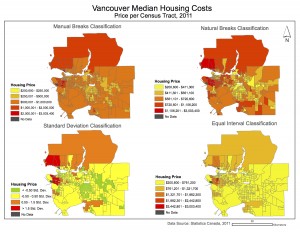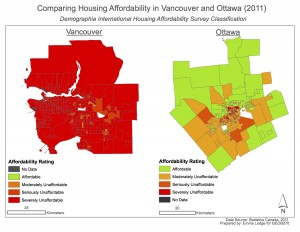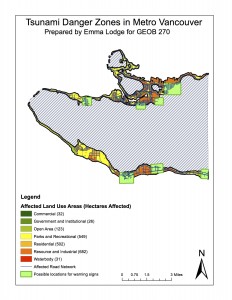Memo
To: Northland Properities and the Aquilini Group
From: Emma Lodge of Big Sky Natural Resource Planning
Date: 2016-03-16
Subject: Garibaldi at Squamish project priorities and planning
The proposed Garibaldi at Squamish year-round resort, which will sit on Brohm Ridge (fifteen kilometers north of Squamish), has the opportunity to become a world-class recreation and commercial facility but attention must be paid in order to preserve the exquisite natural surroundings. While the project was recently approved, forty conditions were put in place to prevent or reduce any significant environmental, social, economic heritage and health effects. As lead Natural resource planner at the retained Big Sky Natural Resource Planning, I write to you today with my recommendations on most critical of these conditions in order to proceed in a way that is viable for your commercial development and the continued care of the natural environment.
In order to analyze the project and criticisms, we used advanced computer software to analyze the geographic and spatial data (ArcGIS). After collecting all the requisite data, we limited the data and maps to only the proposed area of 5472 HA. This then allowed us to use the software and our knowledge of the project to search the data for areas that would directly impact old growth forest management areas, ungulate winter habitats, red-listed ecosystems and fish habitats. See below for the steps taken and results.
Impacted Areas and Ecosystems
Old growth forest management areas
- Steps: Collected data (DataBC), aggregated sums of all OGMAs within the proposed project boundary
- Findings: 371 HA (7%) of the proposed project area are old growth management areas, and are undevelopable
Ungulate winter habitats
- Steps: Collected data (DataBC), aggregated sums of all ungulate winter habitats within the proposed project boundary
- Findings: 432 HA (8%) of the proposed project area are ungulate wintering areas and are undevelopable
Red-listed ecosystems
- Steps: Collected data, used Environmental Resource Management Ltd.’s listing of common red-listed ecosystems, searched our data set for areas that had the proper Biogeoclimatic unit and soil moisture content, identified the red-listed areas and aggregated sums of all red-listed ecosystems within the proposed project boundary
- Findings: There are Falsebox, Salal, Cladina, Kinnikinnick, Flat Moss, Cat’s-Tail Mossecosystems within the proposed project area, and they comprise 1358 HA (25%) of the proposed project area
Fish Habitats
- Steps: Collected river data, knowing that streams above 600m elevation are less likely to be fish-bearing, we created a 50 meter buffer on either side, for streams below 600m this buffer was increased to 100m on either side to protect fish-bearing streams, aggregated all protected habitat within the proposed boundary
- Findings: 1438 HA (26%) of the proposed project area are within fish habitat and riparian areas and are undevelopable
After finding these individually protected areas, we used the software to combine all the areas that have at least one of these protected areas within them, or that are below 600m elevation to discover that 56 percent (2882 HA) of the proposed project falls within this area. Once the data was collected, cleaned up, and the values found, we used mapping software to create a map which highlights the areas that are off-limits to development. This map is included in our report, with the problematic areas highlighted. It should also be noted that a small section of the project falls within a protected park and is undevelopable.
Our analysis of the data and the creation of this map lead me to advise that the greatest environmental concerns for the proposed Garibaldi at Squamish project are to avoid the environmentally sensitive areas that are protected and that the resort and ski trails have limited impact on fish-bearing habitats. While these areas take up a large percentage of the project area, they mostly fall beneath the 600m contour line which is unadvisable to build on as this area does not receive adequate snowfall. Therefore, these issues could be mitigated by building above 600m elevation and by using previously build roads in order to limit the environmental impact of building new ones.
While there are hurdles to overcome, we believe that with adequate environmental protections and precautions the Garibaldi at Squamish resort has the potential to raise the profile of the Sea-to-Sky corridor and positively impact the region.
Sincerely,
Emma Lodge
Lead Planner
Big Sky Natural Resource Planning
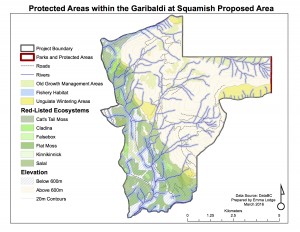
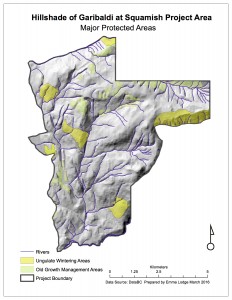
The above memo was created as part of a scenario in which I was assigned to be a proponent of the Garibaldi at Squamish resort development. In reality, I do not think that the resort development should proceed because the area that is being suggested falls within major old growth forest management areas, is surrounded by red listed ecosystems and directly impacts ungulate wintering areas. Therefore, the impact of the resort would outweigh the benefits of its construction.


